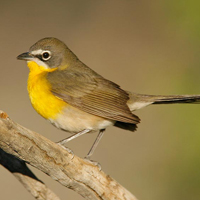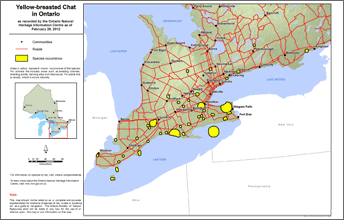Yellow-breasted chat
Scientific name: Icteria virens

Cover photo credit: Brian E. Small
Status
Endangered
“Endangered” means the species lives in the wild in Ontario but is facing imminent extinction or extirpation.
Date added to the Species at Risk in Ontario List
November 30, 2011
What it looks like
The Yellow-breasted chat is a medium-sized songbird, about 18 centimetres long, with a long tail.
It has a bright yellow chest and throat, olive-green back, white circles around its eyes, white belly and undertail.
Where it lives
The Yellow-breasted chat lives in thickets and scrub, especially locations where clearings have become overgrown.
These birds spend their winters in coastal marshes.
This bird eats insects gathered from the foliage of low, dense shrubs, or from the ground.
Where it’s been found in Ontario
The Yellow-breasted chat is found in much of the United States.
In Canada, it lives in southern British Columbia, the Prairies, and southwestern Ontario, where it is concentrated in Point Pelee National Park and Pelee Island in Lake Erie. This bird winters along the Gulf of Mexico.
View a Larger version of this map (PDF)
What threatens it
Although it was likely never common here, the Yellow-breasted chat’s preferred habitat of overgrown clearings has declined due to development, agriculture, and land management approaches that interfere with natural processes.
Action we are taking
Endangered Species and their general habitat are automatically protected.
Recovery strategy
A recovery strategy advises the ministry on ways to ensure healthy numbers of the species return to Ontario.
Read the executive summary and the full document (April 28, 2020).
Government response statement
A government response statement outlines the actions the government intends to take or support to help recover the species.
Read the government response statement (January 29, 2021)
Habitat protection
General Habitat Protection - January 24, 2013
What you can do
Report a sighting
- Report a sighting of an endangered animal or plant to the Natural Heritage Information Centre. Photographs with specific locations or mapping coordinates are always helpful.
- Bird Studies Canada is working to advance the understanding, appreciation and conservation of wild birds and their habitat in Ontario and elsewhere; for more information on how you can help, visit:
www.bsc-eoc.org
Volunteer
Volunteer with your local nature club or provincial park to participate in surveys or stewardship work focused on species at risk.
Be a good steward
- private land owners have a very important role to play in species recovery; if you find a Yellow-breasted chat on your land, you may be eligible for stewardship programs that support the protection and recovery of species at risk and their habitats
- the Canada-Ontario Farm Stewardship Program is available to farmers registered under the Canada-Ontario Environmental Farm Plan to encourage greater protection and conservation of habitat for species at risk
Report illegal activity
Report any illegal activity related to plants and wildlife to
Quick facts
- the Yellow-breasted chat’s song consists of a weird assortment of clicks, whistles ands even chuckles
- Yellow-breasted chats in Ontario tend to be more subdued in colour than their relatives in western Canada, and separate subspecies are recognized
- this chat’s nest is a bulky cup of grasses, leaves, strips of bark, and stems of weeds; it is lined with finer grasses, wiry plant stems, pine needles, and sometimes roots and hair
